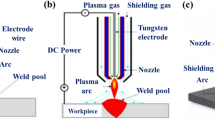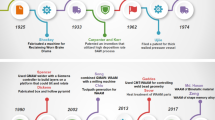Abstract
Wire arc additive manufacturing (WAAM) is attractive to replace conventional subtractive manufacturing techniques to produce unique, complex and large-sized components. However, the multi-pass deposition thermal cycles of a WAAM process often generate columnar grain structures in the microstructures of components. These components exhibit anisotropic mechanical properties, which render them unsuitable for major engineering applications. In this work, metal transfer characteristics in a gas metal arc (GMA)-based WAAM process and its influence on microstructural evolution were studied to propose an optimum deposition technique to generate equi-axed grains containing microstructures. Results showed that the microstructure of conventional pulsed mode deposition contained long and columnar grains while short-circuited deposition produced randomly oriented near equi-axed grains. High-speed camera imaging was used to study and optimize the metal transfer characteristics. Detailed microscopy analysis and tensile testing were carried out to confirm the isotropic nature of the deposits.




















Similar content being viewed by others
Change history
04 February 2020
The original version of this article unfortunately contained a mistake. The symbol below eq. 2 on page 397 to denote deposition speed is displayed in an Asian character. It should be “v” instead of the Asian charater. The sentence should read ‘..and v is the deposition speed.
04 February 2020
The original version of this article unfortunately contained a mistake. The symbol below eq. 2 on page 397 to denote deposition speed is displayed in an Asian character. It should be ���v��� instead of the Asian charater. The sentence should read ���..and v is the deposition speed.
04 February 2020
The original version of this article unfortunately contained a mistake. The symbol below eq. 2 on page 397 to denote deposition speed is displayed in an Asian character. It should be ���v��� instead of the Asian charater. The sentence should read ���..and v is the deposition speed.
References
RAMLAB (2011) World’s first class approved 3D printed ship’s propeller. https://ramlab.com/updates/ramlab-unveils-worlds-first-class-approved-3d-printed-ships-propeller/. Accessed 29 Jan 2019
Kong D, Dong C, Ni X, Man C, Xiao K, Li X (2018) Insight into the mechanism of alloying elements (Sn, be) effect on copper corrosion during long-term degradation in harsh marine environment. Appl Surf Sci 455:543–553
Kou S (2003) Welding Metallurgy 2nd edn https://doi.org/10.1016/j.theochem.2007.07.017
Queguineur A, Rückert G, Cortial F, Hascoët JY (2018) Evaluation of wire arc additive manufacturing for large-sized components in naval applications. Weld World 62:259–266
DebRoy T, Wei HL, Zuback JS, Mukherjee T, Elmer JW, Milewski JO, Beese AM, Wilson-Heid A, De A, Zhang W (2018) Additive manufacturing of metallic components – process, structure and properties. Prog Mater Sci 92:112–224
Ning F, Cong W (2017) Microstructures and mechanical properties of Fe-Cr stainless steel parts fabricated by ultrasonic vibration-assisted laser engineered net shaping process. Mater Lett 179:61–64
Tian Y, Shen J, Hu S, Wang Z, Gou J (2018) Effects of ultrasonic vibration in the CMT process on welded joints of Al alloy. J Mater Process Technol 259:282–291
Manogharan G, Yelamanchi B, Aman R, Mahbooba Z (2016) Experimental study of disruption of columnar grains during rapid solidification in additive manufacturing. JOM 68:842–849
Ho IT, Chen YT, Yeh AC, Chen CP, Jen KK (2018) Microstructure evolution induced by inoculants during the selective laser melting of IN718. Addit Manuf 21:465–471
McAndrew AR, Alvarez RM, Colegrove PA, Hönnige JR, Ho A, Fayolle R, Eyitayo K, Stan I, Sukrongpang P, Crochemore A, Pinter Z (2018) Interpass rolling of Ti-6Al-4V wire + arc additively manufactured features for microstructural refinement. Addit. Manuf. 21:340–349
Xu X, Ganguly S, Ding J, Seow CE, Williams S (2018) Enhancing mechanical properties of wire + arc additively manufactured INCONEL 718 superalloy through in-process thermomechanical processing. Mater Des 160:1042–1051
Guo J, Zhou Y, Liu C, Wu Q, Chen X, Lu J (2016) Wire arc additive manufacturing of AZ31 magnesium alloy: grain refinement by adjusting pulse frequency. Materials (Basel) 823(9):1–13
Wu Q, Lu J, Liu C, Fan H, Shi X, Fu J, Ma S (2017) Effect of molten pool size on microstructure and tensile properties of wire arc additive manufacturing of Ti-6Al-4V alloy. Materials (Basel) 10:1–11
Plotkowski A, Kirka MM, Babu SS (2017) Verification and validation of a rapid heat transfer calculation methodology for transient melt pool solidification conditions in powder bed metal additive manufacturing. Addit. Manuf. 18:256–268
Norrish J (2017) Recent gas metal arc welding (GMAW) process developments: the implications related to international fabrication standards. Weld World 61:755–767
Author information
Authors and Affiliations
Corresponding author
Additional information
Publisher’s note
Springer Nature remains neutral with regard to jurisdictional claims in published maps and institutional affiliations.
Recommended for publication by Commission XII - Arc Welding Processes and Production Systems
This article is part of the collection on Additive Manufacturing - Processes, Simulation and Inspection
Rights and permissions
About this article
Cite this article
Baby, J., Amirthalingam, M. Microstructural development during wire arc additive manufacturing of copper-based components. Weld World 64, 395–405 (2020). https://doi.org/10.1007/s40194-019-00840-y
Received:
Accepted:
Published:
Issue Date:
DOI: https://doi.org/10.1007/s40194-019-00840-y




